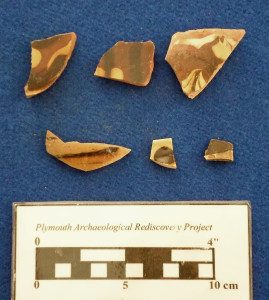Slipwares are ceramics with an earthenware base and coated with a yellow lead glaze which is decorated with brown trailed or combed decoration. This ceramic type was produced first by the Romans but became popular during the reign of Charles I (1630-1685). Slipware produced in the Staffordshire region of England were exported to the North American colonies from the late 17th century until the American Revolution (c.1675-1775). It is a thin, buff-bodied was coated with slips and decorated with trailed, combed and marbled designs. By the late 17th century, exported slipware was generally used by less affluent classes of society (poor to middle class) as well as in taverns and as a general rule, finely executed decorated examples date earlier than more coarsely decorated ones. Vessel forms included drinking vessels (cups, tygs, mugs, posset pots, puzzle jugs) and dishes/ plates, as well as a wide variety of other forms that are less commonly recovered archaeologically (bowls, drug jars, honey pots, teapots, jugs, candlesticks, chamber pots) (Noël Hume 1970).
A total of 19 pieces of Staffordshire slipware were recovered. The vessel forms were limited to one pan and at least one cup
